Water Resources Allocation Based on Complex Adaptive System Theory in the Inland River Irrigation District
Abstract
1. Introduction
2. Model Building
2.1. CAS of Water Resources in Irrigation District
2.2. Agent Classification and Model Framework
2.3. Management Agent Model
2.3.1. Water Resource Allocation System
2.3.2. Land Management
2.3.3. Ecological Management
2.3.4. Social Statistics
2.3.5. Adaptability Description
2.4. Department-Level Agent Model
2.4.1. Ecological Agent Model
2.4.2. Agricultural Production Model Agent
3. Model Solving
3.1. Model Algorithm
3.2. Model Operation Rules
4. Case Study
4.1. General Situation of Irrigation District
4.2. Boundary Condition Calibration
4.3. Results and Discussion
4.3.1. Water Utilization Behavior of Agents
4.3.2. Analysis of Water Resources Allocation Results
5. Conclusions
Author Contributions
Funding
Institutional Review Board Statement
Informed Consent Statement
Data Availability Statement
Acknowledgments
Conflicts of Interest
References
- Jiaxin, W.; Xiaodong, G.; Yanqing, Z.; Pute, W.; Xining, Z. Impact of conservation practices on soil hydrothermal properties and crop water use efficiency in a dry agricultural region of the tibetan plateau. Soil Tillage Res. 2020, 200, 104619. [Google Scholar]
- Xia, J.; Lu, Z.; Liu, C.; Yu, J. Towards better water security in North China. Water Resour. Manag. 2007, 21, 233–247. [Google Scholar] [CrossRef]
- Zhang, M.; Shuai, W.; Fu, B.; Gao, G.; Qin, S. Ecological effects and potential risks of the water diversion project in the Heihe River Basin. Sci. Total Environ. 2017, 619–620, 794–803. [Google Scholar] [CrossRef] [PubMed]
- Sophocleous, M. From safe yield to sustainable development of water resources—The Kansas experience. J. Hydrol. 2000, 235, 27–43. [Google Scholar] [CrossRef]
- Holland, J.H. Studying Complex Adaptive Systems. J. Syst. Sci. Complex. 2006, 19, 1–8. [Google Scholar] [CrossRef]
- Grayson, R.B.; Doolan, J.M.; Blake, T. Application of AEAM (Adaptive Environmental Assessment and Management) to Water Quality in the Latrobe River Catchment. J. Environ. Manag. 1994, 41, 245–258. [Google Scholar] [CrossRef]
- Georgakakos, A.P.; Yao, H.; Kistenmacher, M.; Georgakakos, K.P.; Graham, N.E.; Cheng, F.-Y.; Spencer, C.; Shamir, E. Value of adaptive water resources management in Northern California under climatic variability and change: Reservoir management. J. Hydrol. 2011, 412, 34–46. [Google Scholar] [CrossRef]
- Rammel, C.; Stagl, S.; Wilfing, H. Managing complex adaptive systems—A co-evolutionary perspective on natural resource management. Ecol. Econ. 2006, 63, 9–21. [Google Scholar] [CrossRef]
- Meek, J.W.; Marshall, K.S. Cultivating resiliency through system shock: The Southern California metropolitan water management system as a complex adaptive system. Public Manag. Rev. 2018, 20, 1088–1104. [Google Scholar] [CrossRef]
- Zhao, J.; Wang, Z.; Weng, W. Study on the holistic model for water resources system. Sci. China Ser. E 2004, 47, 72–89. [Google Scholar] [CrossRef]
- Akhbari, M.; Grigg, N.S. A Framework for an Agent-Based Model to Manage Water Resources Conflicts. Water Resour. Manag. 2013, 27, 4039–4052. [Google Scholar] [CrossRef]
- Mialhe, F.; Becu, N.; Gunnell, Y. An agent-based model for analyzing land use dynamics in response to farmer behaviour and environmental change in the Pampanga delta (Philippines). Agric. Ecosyst. Environ. 2012, 161, 55–69. [Google Scholar] [CrossRef]
- Vervoort, J.M.; Thornton, P.K.; Kristjanson, P.; Förch, W.; Ericksen, P.J.; Kok, K.; Ingram, J.S.I.; Herrero, M.; Palazzo, A.; Helfgott, A.E.S.; et al. Challenges to scenario-guided adaptive action on food security under climate change. Glob. Environ. Chang. Hum. Policy Dimens. 2014, 28, 383–394. [Google Scholar] [CrossRef]
- Arnold, R.T.; Troost, C.; Berger, T. Quantifying the economic importance of irrigation water reuse in a C hilean watershed using an integrated agent-based model. Water Resour. Res. 2015, 51, 648–668. [Google Scholar] [CrossRef]
- Zhang, H.; Ren, Q.; Li, J. How to Improve Water Resources Allocation Efficiency: A Two-Stage Performance-Based Allocation Mechanism. Sustainability 2019, 11, 6021. [Google Scholar] [CrossRef]
- Liu, H.; Zhao, Y.; Li, H.; Wang, L.; Wang, Q. Individual Water-Saving Response Based on Complex Adaptive System Theory: Case Study of Beijing City, China. Water 2020, 12, 1478. [Google Scholar] [CrossRef]
- Castilla-Rho, J.C.; Mariethoz, G.; Rojas, R.; Andersen, M.S.; Kelly, B.F.J. An agent-based platform for simulating complex human-aquifer interactions in managed groundwater systems. Environ. Modell. Softw. 2015, 73, 305–323. [Google Scholar] [CrossRef]
- Borgomeo, E.; Hall, J.W.; Salehin, M. Avoiding the water-poverty trap: Insights from a conceptual human-water dynamical model for coastal Bangladesh. Int. J. Water Resour. Dev. 2018, 34, 900–922. [Google Scholar] [CrossRef]
- Srinivasan, V.; Lambin, E.F.; Gorelick, S.M.; Thompson, B.H.; Rozelle, S. The nature and causes of the global water crisis: Syndromes from a meta-analysis of coupled human-water studies. Water Resour. Res. 2012, 48, W10516. [Google Scholar] [CrossRef]
- Doran, J. Intervening to Achieve Co-Operative Ecosystem Management: Towards an Agent Based Model. JASSS 2001, 4, 4. [Google Scholar]
- Anthony, P.; Birendra, K. Improving irrigation water management using agent technology. N. Z. J. Agric. Res. 2018, 61, 425–439. [Google Scholar] [CrossRef]
- Darbandsari, P.; Kerachian, R.; Malakpour-Estalaki, S. An Agent-based Behavioral Simulation Model for Residential Water Demand Management: A Case-Study of the Tehran City. Simul. Model. Pract. Theory 2017, 78, 51–72. [Google Scholar] [CrossRef]
- Lin, Z.; Lim, S.H.; Lin, T.; Borders, M. Using Agent-Based Modeling for Water Resources Management in the Bakken Region. J. Water Resour. Plan. Manag. ASCE 2020, 146, 05019020. [Google Scholar] [CrossRef]
- Ng, T.L.; Eheart, J.W.; Cai, X.; Braden, J.B. An agent-based model of farmer decision-making and water quality impacts at the watershed scale under markets for carbon allowances and a second-generation biofuel crop. Water Resour. Res. 2011, 47, 113–120. [Google Scholar] [CrossRef]
- Yang, Y.C.E.; Cai, X.; Stipanovic, D.M. A Decentralized Optimization Algorithm for Multi-Agent System Based Watershed Management. Water Resour. Res. 2009, 45, 8430. [Google Scholar] [CrossRef]
- Dehghanipour, A.H.; Schoups, G.; Zahabiyoun, B.; Babazadeh, H. Meeting agricultural and environmental water demand in endorheic irrigated river basins: A simulation-optimization approach applied to the Urmia Lake basin in Iran. Agric. Water Manag. 2020, 241, 106353. [Google Scholar] [CrossRef]
- Adu, M.O.; Yawson, D.O.; Abano, E.E.; Asare, P.A.; Opoku, E.K. Does water-saving irrigation improve the quality of fruits and vegetables? Evidence from meta-analysis. Irrig. Sci. 2019, 37, 669–690. [Google Scholar] [CrossRef]
- Nouri, A.; Saghafian, B.; Delavar, M.; Bazargan-Lari, M.R. Agent-Based Modeling for Evaluation of Crop Pattern and Water Management Policies. Water Resour. Manag. 2019, 33, 3707–3720. [Google Scholar] [CrossRef]
- Ghazali, M.; Honar, T.; Nikoo, M.R. A hybrid TOPSIS-agent-based framework for reducing the water demand requested by stakeholders with considering the agents’ characteristics and optimization of cropping pattern. Agric. Water Manag. 2018, 199, 71–85. [Google Scholar] [CrossRef]
- Charizopoulos, N.; Zagana, E.; Psilovikos, A. Assessment of natural and anthropogenic impacts in groundwater, utilizing multivariate statistical analysis and inverse distance weighted interpolation modeling: The case of a Scopia basin (Central Greece). Environ. Earth Sci. 2018, 77, 380. [Google Scholar] [CrossRef]
- Psilovikos, A.; Tzimopoulos, C. Comparison of quadratic and non-linear programming (QP and NLP) optimization models in groundwater management. J. Hydroinform. 2004, 6, 175–185. [Google Scholar] [CrossRef][Green Version]
- Pham, L.T.; Otto, I.M.; Zikos, D. Self-Governance and the Effects of Rules in Irrigation Systems: Evidence from Laboratory and Framed Field Experiments in China, India and Vietnam. Water Econ. Policy 2019, 5, 1850009. [Google Scholar] [CrossRef]
- Aljanabi, A.; Mays, L.; Fox, P. Optimization Model for Agricultural Reclaimed Water Allocation Using Mixed-Integer Nonlinear Programming. Water 2018, 10, 1291. [Google Scholar] [CrossRef]
- Kim, D.; Kaluarachchi, J.J. A risk-based hydro-economic analysis for land and water management in water deficit and salinity affected farming regions. Agric. Water Manag. 2016, 166, 111–122. [Google Scholar] [CrossRef]
- Al-Amin, S.; Berglund, E.Z.; Mahinthakumar, G.; Larson, K.L. Assessing the effects of water restrictions on socio-hydrologic resilience for shared groundwater systems. J. Hydrol. 2018, 566, 872–885. [Google Scholar] [CrossRef]
- Archibald, T.W.; Marshall, S.E. Review of Mathematical Programming Applications in Water Resource Management Under Uncertainty. Environ. Model. Softw. 2018, 23, 753–777. [Google Scholar] [CrossRef]
- Zhang, Y.F.; Li, Y.P.; Sun, J.; Huang, G.H. Optimizing water resources allocation and soil salinity control for supporting agricultural and environmental sustainable development in Central Asia. Sci. Total Environ. 2020, 704, 135281. [Google Scholar] [CrossRef] [PubMed]
- Bekchanov, M.; Lamers, J. Economic costs of reduced irrigation water availability in Uzbekistan (Central Asia). Reg. Environ. Chang. 2016, 16, 2369–2387. [Google Scholar] [CrossRef]
- Gomiero, T.; Pimentel, D.; Paoletti, M.G. Is There a Need for a More Sustainable Agriculture? Crit. Rev. Plant Sci. 2011, 30, 6–23. [Google Scholar] [CrossRef]
- Guo, J.; Xu, H.; Zhang, G.; Yuan, K.; Ling, H. The Enhanced Management of Water Resources Improves Ecosystem Services in a Typical Arid Basin. Sustainability 2020, 12, 8802. [Google Scholar] [CrossRef]
- Chong, J.; Zhang, L. Climate Change and Its Impact on the Eco-Environment of the Three-Rivers Headwater Region on the Tibetan Plateau, China. Int. J. Environ. Res. Public Health 2015, 12, 12057–12081. [Google Scholar]
- Ye, B.; Yang, D.; Zhang, Z.; Kane, D. Variation of hydrological regime with permafrost coverage over Lena Basin in Siberia. J. Geophys. Res. Atmos. 2009, 114, D07102. [Google Scholar] [CrossRef]
- García-Tejero, I.; Arriaga, J.; Durán-Zuazo, V.; Muriel-Fernández, J. Predicting crop-water production functions for long-term effects of deficit irrigation on citrus productivity (SW Spain). Arch. Agron. Soil Sci. 2013, 59, 1591–1606. [Google Scholar] [CrossRef]
- Surendran, U.; Sushanth, C.M.; Mammen, G.; Joseph, E.J. Modelling the Crop Water Requirement Using FAO-CROPWAT and Assessment of Water Resources for Sustainable Water Resource Management: A Case Study in Palakkad District of Humid Tropical Kerala, India. Aquat. Procedia 2015, 4, 1211–1219. [Google Scholar] [CrossRef]
- Daryanto, S.; Wang, L.; Jacinthe, P.A. Can ridge-furrow plastic mulching replace irrigation in dryland wheat and maize cropping systems? Agric. Water Manag. 2017, 190, 1–5. [Google Scholar] [CrossRef]
- Li, W.D. Effect of ridge–furrow and plastic-mulching planting patterns on yield formation and water movement of potato in a semi-arid area. Agric. Water Manag. 2014, 131, 87–94. [Google Scholar]
- Guzha, A.C. Effects of tillage on soil microrelief, surface depression storage and soil water storage. Soil Tillage Res. 2004, 76, 105–114. [Google Scholar] [CrossRef]
- Cai, Y.; Yao, C.; Wu, P.; Zhang, L.; Du, Y. Effectiveness of a subsurface irrigation system with ceramic emitters under low-pressure conditions. Agric. Water Manag. 2021, 243, 106390. [Google Scholar] [CrossRef]
- Cai, Y.; Zhao, X.; Wu, P.; Zhang, L.; Zhu, D.; Chen, J.; Lin, L. Ceramic patch type subsurface drip irrigation line: Construction and hydraulic properties. Biosyst. Eng. 2019, 182, 29–37. [Google Scholar] [CrossRef]
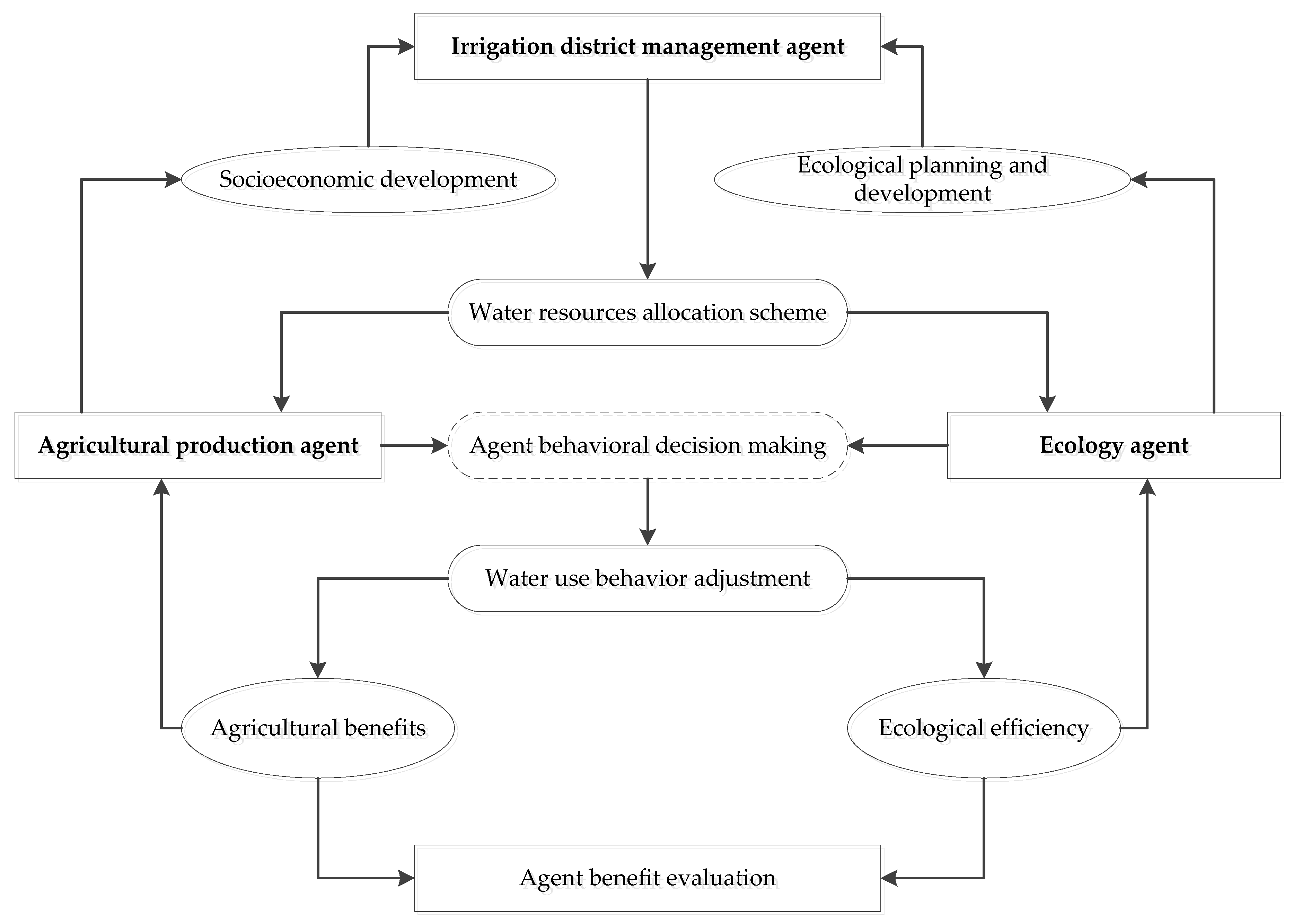
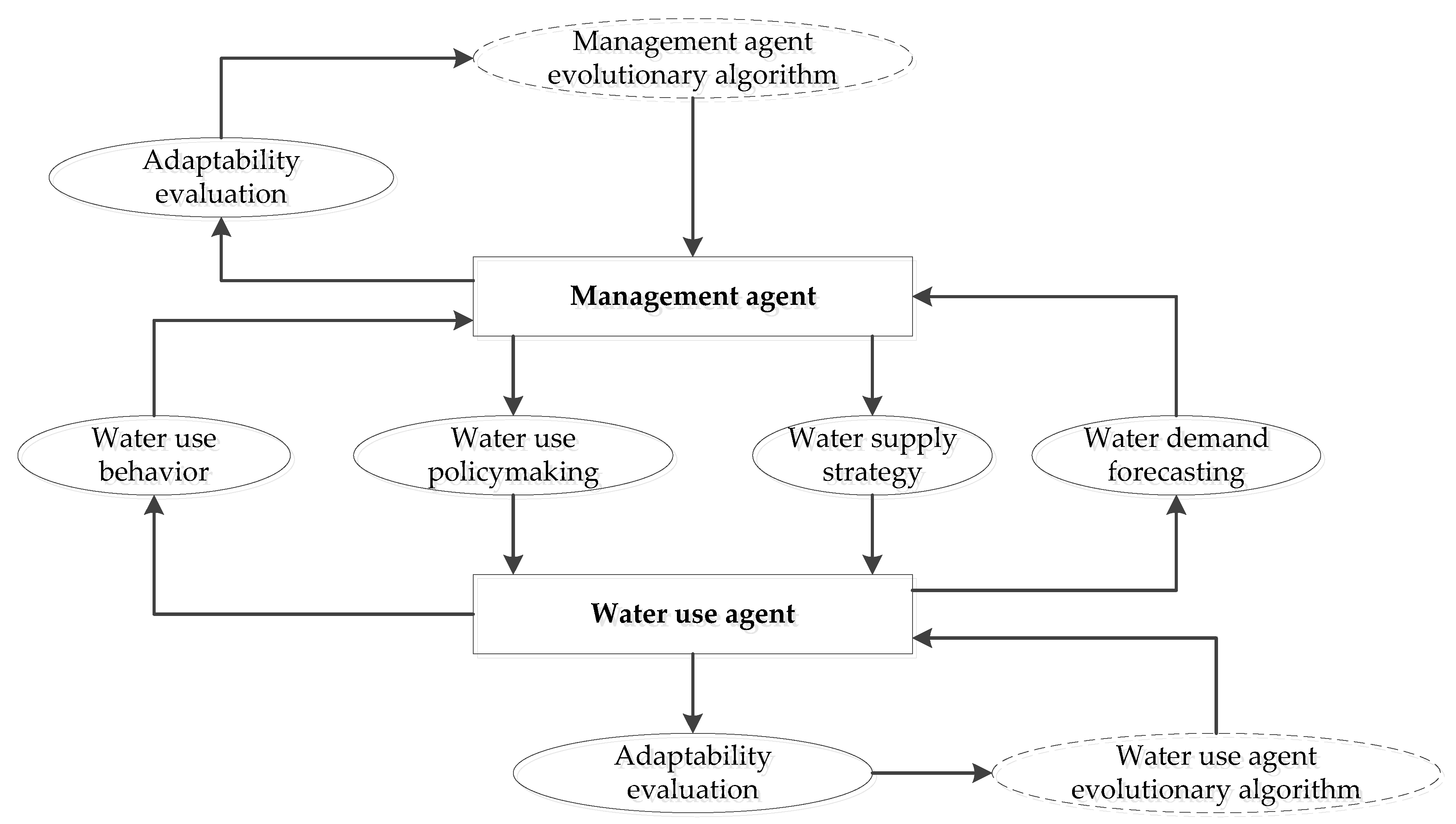
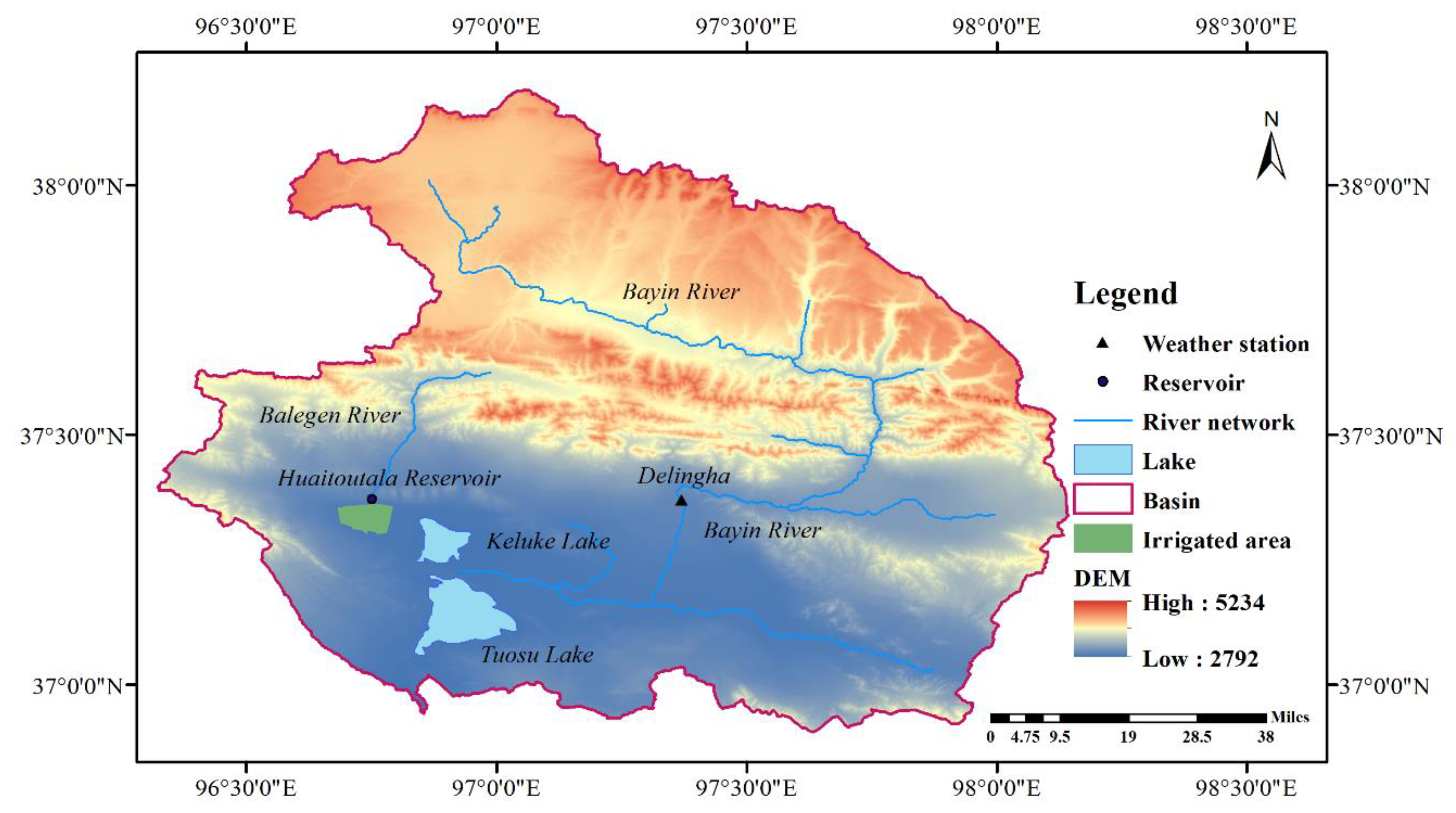
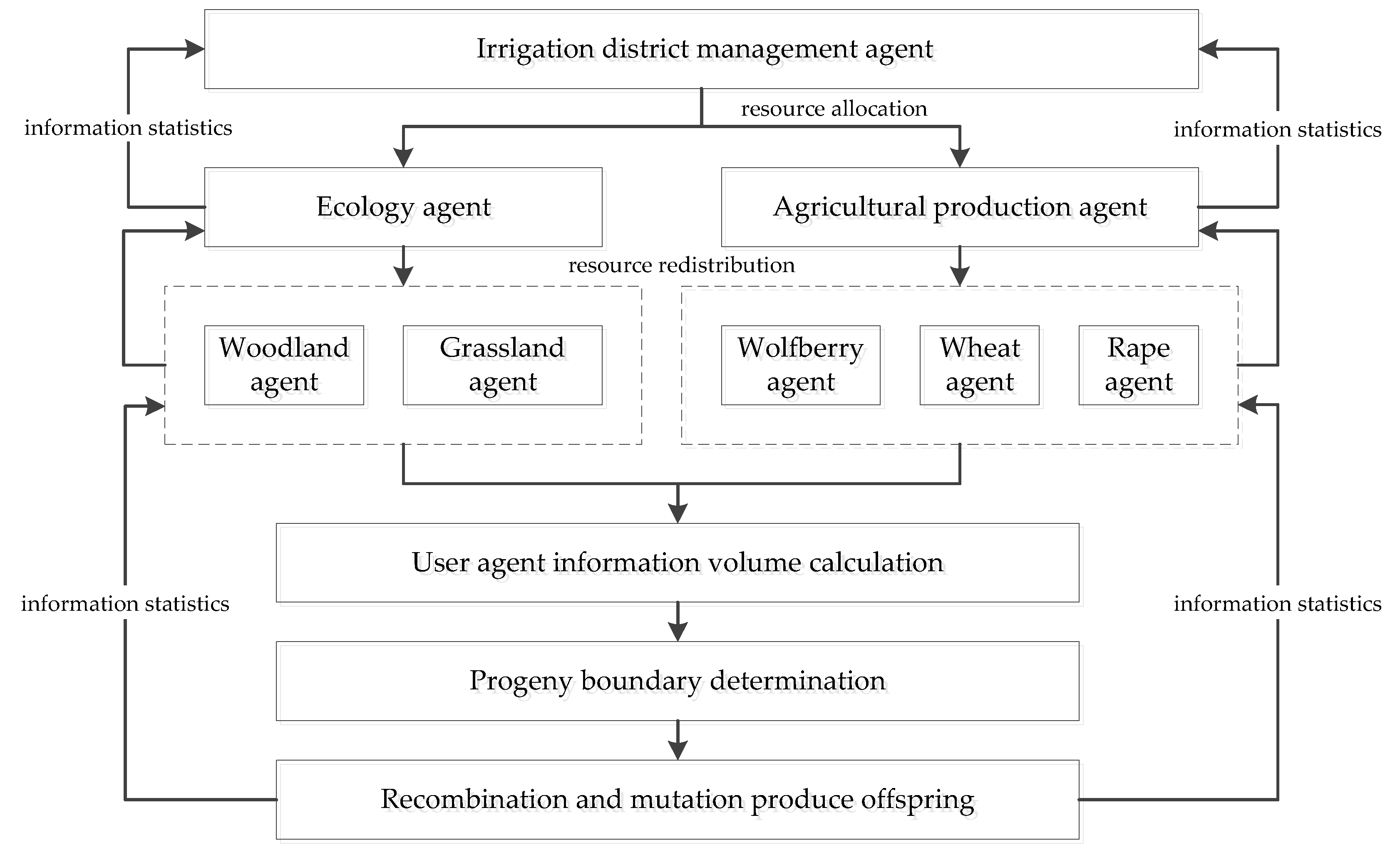
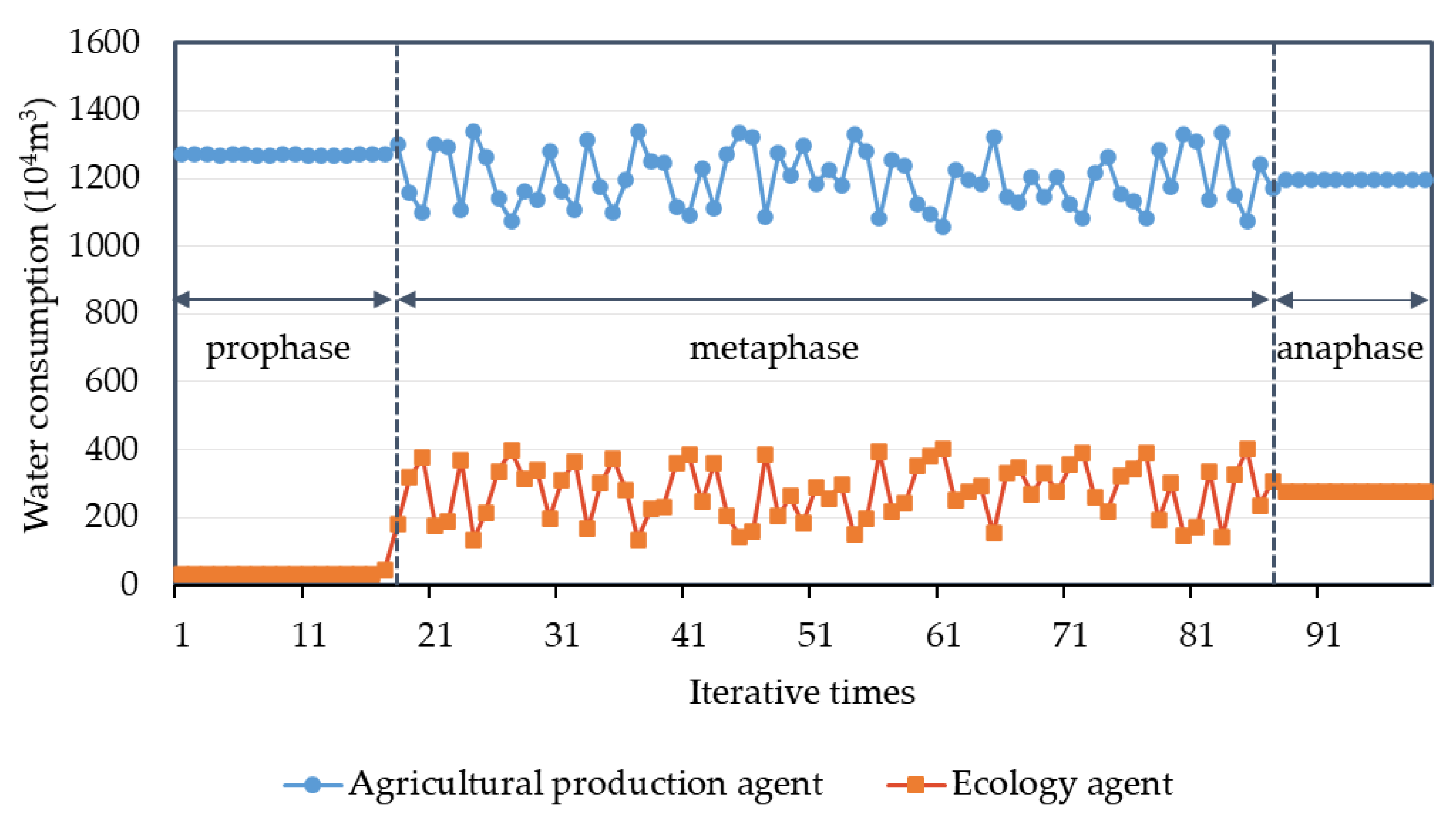



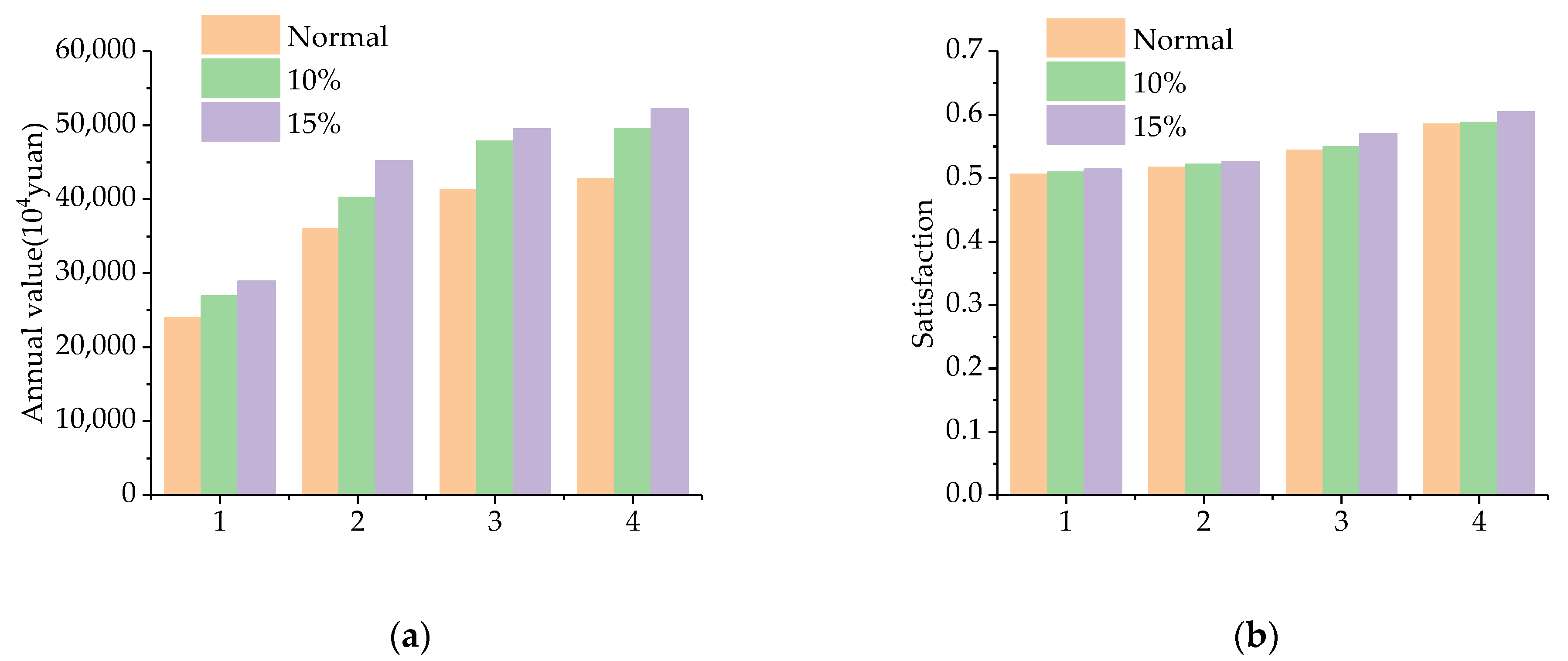
| Evaluating Indicator | Weight |
|---|---|
| Precipitation (mm) | 0.4 |
| Woodland coverage (%) | 0.2 |
| Grassland area ratio (%) | 0.2 |
| Water area ratio (%) | 0.1 |
| Runoff () | 0.1 |
| Type | Wolfberry | Wheat | Rape | Woodland | Grassland |
|---|---|---|---|---|---|
| Area | 1923 | 506 | 143 | 16 | 73 |
| Water consumption | 4500 | 5775 | 4125 | 5400 | 3600 |
| Scenario | Irrigation Scheme |
|---|---|
| 1 | FN + FI |
| 2 | RM + DI |
| 3 | RM + MC + DI |
| 4 | RM + MC + CI |
| Scenario | Characteristic Year | Water Consumption (104 m3) | Yield | Annual Value (104 RMB) | WUE | |
|---|---|---|---|---|---|---|
| I | Wet | 895.2 | 2646.2 | 1051.4 | 28,839.861 | 2.956 |
| Normal | 834 | 2467.5 | 1049.9 | 26,892.469 | 2.959 | |
| Dry | 691.8 | 2097.1 | 998.3 | 22,860.101 | 3.031 | |
| Wet (15%) 1 | 1080 | 2940.2 | 1165.4 | 32,018.303 | 2.722 | |
| Normal (15%) | 1006 | 2786.2 | 1146.6 | 30,346.245 | 2.771 | |
| Dry (15%) | 873.6 | 2531.5 | 1086.1 | 27,584.809 | 2.898 | |
| IV | Wet | 780.9 | 4719.0 | 1731.4 | 51,674.545 | 6.043 |
| Normal | 740.8 | 4513.6 | 1674.0 | 49,427.864 | 6.093 | |
| Dry | 617 | 3809.2 | 1555.8 | 41,716.241 | 6.173 | |
| Wet (15%) | 889.8 | 5301.0 | 1815.8 | 58,043.576 | 5.958 | |
| Normal (15%) | 855.4 | 5116.3 | 1793.8 | 56,023.058 | 5.981 | |
| Dry (15%) | 762.1 | 4648.9 | 1664.5 | 50,909.410 | 6.100 |
| Scenario | Water Consumption (mm) | WUE | WUE Relative Increase (%) | ||
|---|---|---|---|---|---|
| 1 | 2499.615 | 1131.2 | 403.0 | 2.807 | 0 |
| 2 | 2947.855 | 1582.4 | 346.8 | 4.563 | 62.55 |
| 3 | 2942.268 | 1740.5 | 320.9 | 5.424 | 93.22 |
| 4 | 2927.564 | 1773.2 | 295.4 | 6.003 | 113.85 |
| Scenario | Agriculture Water Consumption (104 m3) | Ecology Water Consumption (104 m3) | Total (104 m3) | Yield (t) | Annual Value (104 RMB) | Ecological Water Demand Satisfaction |
|---|---|---|---|---|---|---|
| 1 | 1361.268 | 113.499 | 1474.767 | 7467.282 | 32,308.879 | 0.520 |
| 2 | 1343.263 | 151.467 | 1494.730 | 6857.540 | 52,402.373 | 0.538 |
| 3 | 1289.784 | 203.750 | 1493.534 | 7265.197 | 57,521.468 | 0.579 |
| 4 | 1196.063 | 276.208 | 1472.271 | 7152.435 | 58,295.182 | 0.637 |
Publisher’s Note: MDPI stays neutral with regard to jurisdictional claims in published maps and institutional affiliations. |
© 2021 by the authors. Licensee MDPI, Basel, Switzerland. This article is an open access article distributed under the terms and conditions of the Creative Commons Attribution (CC BY) license (https://creativecommons.org/licenses/by/4.0/).
Share and Cite
Xing, H.; Mo, S.; Liang, X.; Li, Y. Water Resources Allocation Based on Complex Adaptive System Theory in the Inland River Irrigation District. Sustainability 2021, 13, 8437. https://doi.org/10.3390/su13158437
Xing H, Mo S, Liang X, Li Y. Water Resources Allocation Based on Complex Adaptive System Theory in the Inland River Irrigation District. Sustainability. 2021; 13(15):8437. https://doi.org/10.3390/su13158437
Chicago/Turabian StyleXing, Hua, Shuhong Mo, Xiaoyan Liang, and Ying Li. 2021. "Water Resources Allocation Based on Complex Adaptive System Theory in the Inland River Irrigation District" Sustainability 13, no. 15: 8437. https://doi.org/10.3390/su13158437
APA StyleXing, H., Mo, S., Liang, X., & Li, Y. (2021). Water Resources Allocation Based on Complex Adaptive System Theory in the Inland River Irrigation District. Sustainability, 13(15), 8437. https://doi.org/10.3390/su13158437






